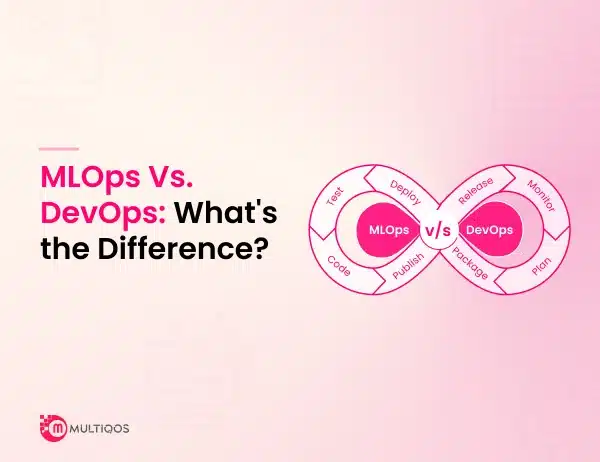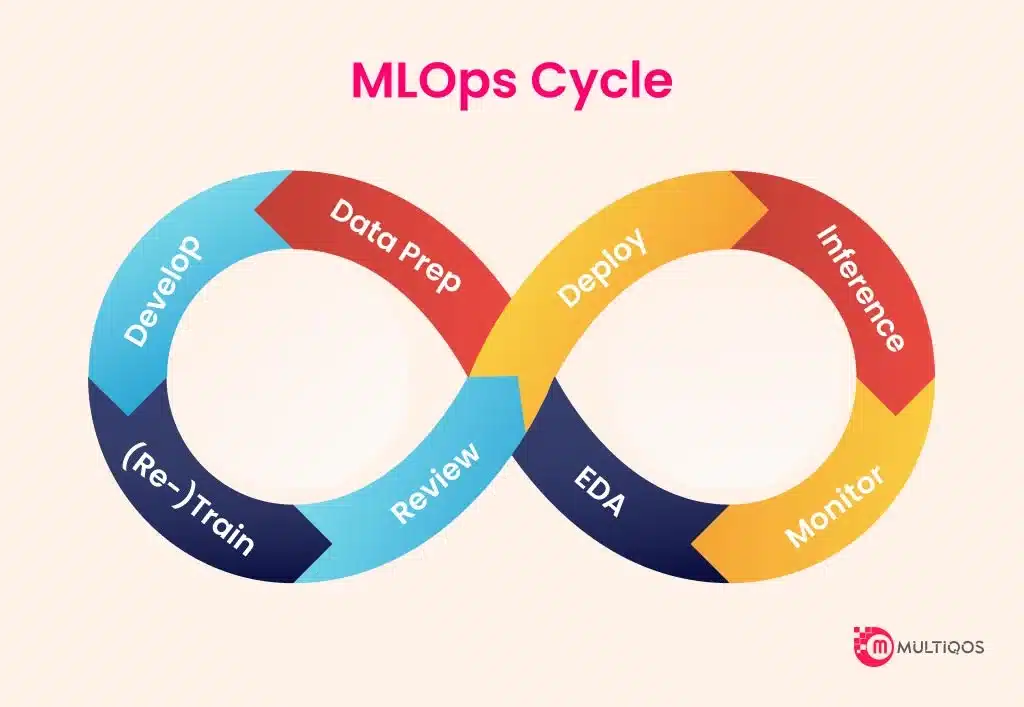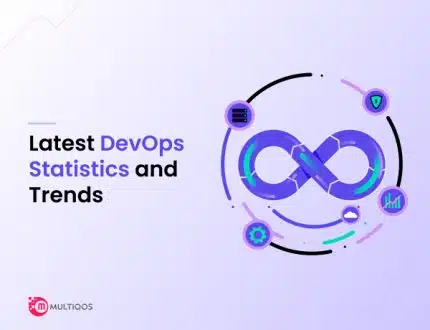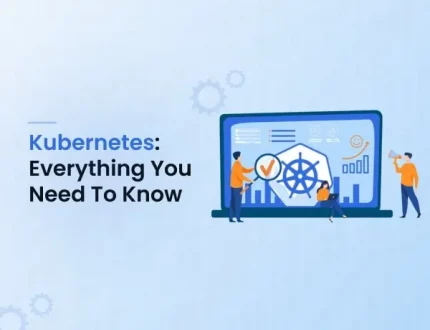MLOps vs DevOps: Understanding Significant Differences

In today’s fast-paced world, companies are increasingly relying on artificial intelligence (AI) and machine learning (ML) technologies to stay ahead of the competition and drive innovation. As the use of ML models grows, managing their lifecycle efficiently has become crucial. This is where Machine Learning Operations (MLOps) comes into play – an approach based on the well-established DevOps principles.
While MLOps and DevOps share some similarities, it is essential to understand their key differences to ensure organizations succeed in their respective areas.
This comprehensive blog aims to provide a clear and straightforward explanation of the distinctions between MLOps and DevOps. By thoroughly exploring these differences, companies can pave the way for successful Machine Learning development and gain a competitive edge in their respective industries.
Understanding MLOps: Streamlining the ML Lifecycle
MLOps, an amalgamation of “Machine Learning” and “Operations,” is a set of practices that combines principles from DevOps with machine learning. Machine Learning Operations (MLOps) is a set of practices that help organizations to efficiently build, deploy, and maintain machine learning models in production.
Its main objective is to smoothen and automate the entire lifecycle of ML models, starting from data preparation and model training all the way to deployment, monitoring, and retraining when needed. The MLOps approach acknowledges the distinct challenges that come with deploying and managing ML models, which are fundamentally different from traditional software applications. Here’s a typical workflow for machine learning that MLOps aims to optimize:
- Data Preparation: Acquiring, cleaning, and preparing data for ML models, ensuring data versioning and reproducibility.
- Model Development: Developing, training, and validating ML models by ML engineers and data scientists, with version control for ML artifacts.
- Model Deployment: Automating the deployment process of ML models to production environments.
- Monitoring and Logging: Continuously monitoring model performance, detecting issues like concept drift, and logging insights for further analysis.
- Feedback Loop: Incorporating feedback and improvements into the ML model based on monitoring and user feedback, maintaining its relevance over time.
- Scaling and Retraining: Scaling ML models to support performance demands and periodically retraining them to ensure their effectiveness.
Understanding DevOps: Bridging Development and Operations
DevOps, a well-established methodology, aims to bridge the gap between software development and IT operations teams. DevOps emphasizes a collaborative and automated approach to software delivery, enabling organizations to deliver high-quality software faster and more reliably.
The core principles of DevOps include:
- Continuous Integration (CI): Developers regularly integrate code changes and run automated tests to detect issues early.
- Continuous Deployment (CD): Automating the release pipeline to rapidly deploy quality, secure, and reliable code to production.
- Infrastructure as Code (IaC): Automating the provisioning and management of infrastructure using code, ensuring scalability and consistency.
- Continuous Monitoring: Implementing feedback loops and continuous monitoring to enable proactive issue resolution.
- Microservices Architecture: Breaking down complex applications into smaller, independently deployable services for agility and scalability.
- Containerization: Encapsulating applications with their dependencies into lightweight, portable containers for consistent performance across environments.
By adopting DevOps practices, organizations can accelerate software delivery, improve collaboration between teams, increase efficiency through automation, enhance code quality and reliability, and reduce costs associated with manual processes and issue resolution.
Bridging the Gap: MLOps vs DevOps Similarities
While MLOps and DevOps have distinct focuses, they share some common ground and principles:
- Collaborative Culture: Both methodologies emphasize breaking down silos and fostering collaboration between teams, including development, operations, and domain experts
- Agile Principles: MLOps and DevOps embrace Agile principles, ensuring efficient delivery of software components or ML models through iterative Machine Learning development and continuous improvement.
- Automation and Efficiency: Both approaches prioritize automation to reduce manual interventions, minimize deployment errors, and increase overall efficiency.
- Continuous Monitoring: Continuous monitoring and feedback loops are integral to both MLOps and DevOps, enabling early issue detection and proactive resolution.
- Shared Tools: While MLOps may require specialized tools for ML-specific tasks, both approaches use some common tools like Git, Jenkins, and Kubernetes for version control, CI/CD pipelines, and containerization.
Decoding the Differences: MLOps vs DevOps
Despite their shared principles, MLOps paradigm and DevOps have distinct differences that organizations must understand to use their full potential:
- Data-Centricity:
-
- DevOps: DevOps practices primarily focus on software/application code, with data playing a secondary role in specific application contexts.
- MLOps: MLOps heavily relies on data for training and validating ML models, making data versioning and quality a critical aspect throughout the ML lifecycle.
- Nature of Work:
-
- DevOps: Focused on application/software development, ensuring continuous delivery, testing, and frequent releases.
- MLOps: Centered around building and deploying ML models, with a stronger emphasis on continuous iteration, monitoring, and model retraining.
- Development Principles:
-
- DevOps: Code creates an executable artifact or interface, which is deployed and tested before being released.
- MLOps: Code enables building and training ML models, with serialized files receiving data inputs for validation and performance evaluation.
- Versioning:
-
- DevOps: Version control primarily tracks changes to source code and artifacts.
- MLOps: Version control extends beyond code to include training datasets, model artifacts, hyperparameters, and model performance metrics.
- Infrastructure and Reusability:
-
- DevOps: Focuses on automating infrastructure deployments with Infrastructure-as-Code and CI/CD automation tools.
- MLOps: Emphasizes reusing workflows and customizing unique requirements for each ML model based on use cases, using deep learning frameworks and cloud storage.
- Experimentation and Monitoring:
-
- DevOps: Monitoring tracks software/application health and performance, often using Site Reliability Engineering (SRE) or conventional programming techniques.
- MLOps: Monitoring involves iterative experimentation with different data sets to fine-tune ML model performance, with a focus on continuous monitoring of model accuracy and relevance.
Achieving Success: Bridging the Gap Between MLOps and DevOps
While MLOps and DevOps have distinct differences, organizations can bridge the gap and use the strengths of both approaches by following these best practices:
- Establish Clear Goals: Define clear objectives for developers, operations teams, and data scientists, aligning their efforts with business objectives and setting realistic timelines.
- Foster Cross-Functionality: Promote cross-functional collaboration among teams, encouraging knowledge sharing and breaking down silos to foster a seamless workflow.
- Maintain Transparency: Ensure transparency about business objectives, processes, and challenges across all teams, encouraging trust and effective communication.
- Automate Workflows: Implement automation for development workflows, continuous delivery, testing, and validation to increase efficiency and reduce manual errors.
- Continuous Validation: Incorporate continuous validation and monitoring processes to ensure the performance and reliability of software applications and ML models.
- Encourage Experimentation: Create an environment that encourages experimentation, innovation, and continuous improvement, allowing teams to explore new approaches and technologies.
- Leverage Specialized Tools: While using common tools, organizations should also invest in specialized tools tailored for MLOps and DevOps tasks to streamline processes and enhance efficiency.
- Implement Feedback Loops: Establish DevOps-based feedback loops to facilitate continuous monitoring, learning, and improvement for both software applications and ML models.
Conclusion
Software advancements and machine learning development fields constantly change. Organizations must know the differences between MLOps and DevOps to succeed. Although both methods share similarities, they have unique challenges, processes, and best practices that require customized approaches.
MLOps address complexities throughout the ML model’s life cycle, including data preparation, model training, deployment, monitoring, and retraining. In contrast, DevOps solutions bridges the gap between development and operations teams, enabling continuous delivery of high-quality software applications.
FAQ on MLOps vs DevOps
Working with ML models has complexities beyond normal software deployment. DevOps methods assist, but don’t cover end-to-end ML needs fully. MLOps expands DevOps principles for building, deploying, and maintaining ML models efficiently.
Yes, MLOps implementation demands expertise in data science and ML workflows. Teams often include data scientists, ML engineers, and subject matter experts. They connect model development with operations easily.
No, MLOps is specifically designed to address the challenges associated with machine learning model development and deployment. For traditional software development projects, DevOps practices are more suitable and widely adopted.
Managing multiple data sources poses difficulties when implementing MLOps. Continuous integration often requires careful versioning of models. Ensuring consistent outcomes across various environments is another hurdle. Additionally, maintaining model performance over time can be challenging due to concept drift or data drift.
While some existing DevOps tools like Git, Jenkins, and Kubernetes can be used in MLOps workflows, there are also specialized tools designed specifically for MLOps tasks, such as MLflow, Kubeflow, and TensorFlow Extended (TFX). Organizations often use a combination of both DevOps and MLOps tools to streamline their processes.
The choice between MLOps and DevOps primarily depends on the nature of the project. If the project involves developing and deploying machine learning models, MLOps practices are more suitable. On the other hand, if the project focuses on traditional software development, DevOps practices would be the better choice.
Get In Touch






